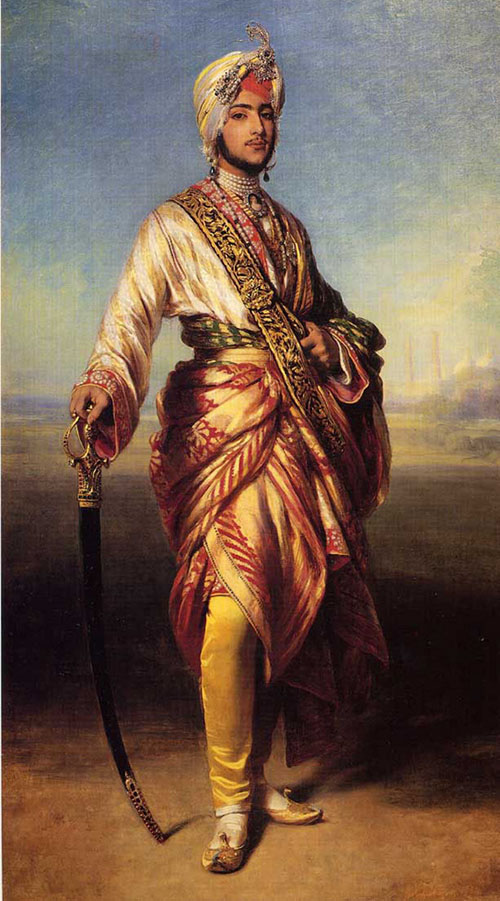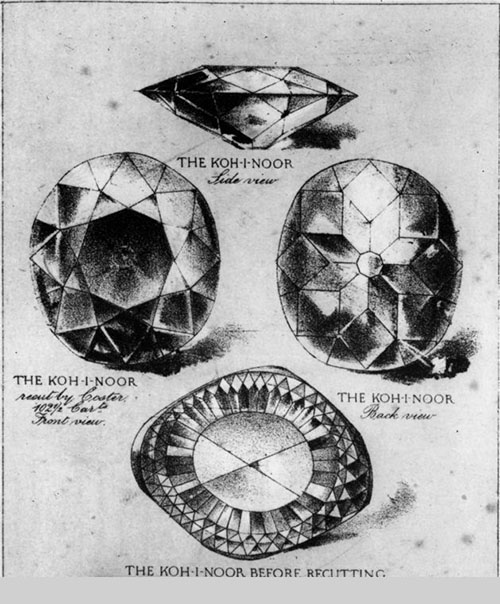This article first appeared in London Historians Members’ Newsletter of December 2013.
by Essie Fox
Most of us are fully aware of Queen Victoria’s terrible grief at the time of her husband’s sudden death. We know the story of John Brown, the servant on whom she came to depend. But there is one story, not so well known, regarding the Queen’s affection for an Indian Maharajah who was brought to live in England when deposed from his Punjabi throne at the end of the second Anglo-Sikh War (1848/9).
The Maharajah Duleep Singh was a handsome and glamorous prince whose life was dramatic and filled with intrigue, not to mention a sad and tragic end. He became the ruler of the Punjab when barely more than an infant. But, by the age of 11, he had been removed from his mother’s care and was held at the fort of Futteghar where, influenced by his new British ‘friends’, he converted to Christianity. After that he was brought to England and became very popular at court where Victoria and Albert encouraged the prince’s friendship with their own royal children.

Also brought to England from India was what had been Duleep’s sovereign symbol: the sacred Koh-i-noor diamond, taken as ransom at the time of the Annexation of Lahore. The diamond inspired much interest when exhibited in 1851 at the Great Exhibition in Hyde Park, after which it was set as a brooch and worn by Queen Victoria. It was reduced to half its size when Prince Albert had its facets re-cut in an effort to improve the way the diamond reflected the light.
It was in the White Room at Buckingham Palace where Duleep and his diamond became reunited – a poignant and symbolic scene when Victoria commissioned Winterhalter, her favourite portrait artist, to make a likeness of the prince in an exotic, idealised work that remains in the Royal Collection today.
One day, while Duleep was posing in his Sikh ceremonial robes the Queen appeared in the White Room too, instructing the prince to close his eyes and hold out his hands – into which she then placed the Koh-i-noor.
No doubt she was only testing the maharajah’s loyalty. And although he had the good sense to hand the stone back into her palms, Duleep admitted to intimates that he had been insulted and was more than tempted to throw the stone out of an open window. He called the Queen Mrs Fagin – the handler of stolen property. He would also have been very much aware of the ancient curse upon the stone – which was that any man who held it would see his line disappear from the light.
Duleep’s line did indeed disappear. He married and had several children, but no grandchildren. And then, in his middle years, when Duleep became disaffected, often asking for the diamond’s return, it could have been that he believed in another well-known prophecy: if the stone was returned to its homeland all foreign invaders would be cast out.
Fearing another Mutiny should Duleep attempt to reclaim his throne, Victoria’s advisors would never consent to giving the diamond back to him. They had the prince followed by British spies and eventually he was exposed as consorting with various dissidents, mainly those Russians and Irishmen with whom he had been making plans to march an army on the Punjab by route of Russia and Afghanistan. Duleep was exiled from England as well as India. He was forced to live out the rest of his life on the European continent, where he died at the age of 55 in a shabby Parisian hotel – but not before Victoria secretly met with pardoned him, and after which she brought her beautiful boy back to be buried in England – despite the maharajah’s wish for his remains to return to his native India.
So, Duleep’s life appeared to be cursed. But Victoria, who still possessed the stone, may well have received its blessings, with the diamond linked to a prophecy that any woman who owned it would then go on to rule the world. She did command an Empire, and became the Empress of India.
Essie Fox’s novel, The Goddess And The Thief features the Maharajah Duleep Singh and the myths surrounding the Koh-i-noor. Her Victorian debut, The Somnambulist, was selected for the Channel 4 Bookclub, and was nominated for the National Book Awards. Her latest book, The Last Days of Leda Grey features the Edwardian world of moving film and was selected as Historical Book of the Month by The Times. It was published in paperback on November 16 2017. Essie blogs as The Virtual Victorian, and her author website has many more details of her novels, with reviews, articles, and upcoming events: www.essiefox.com
